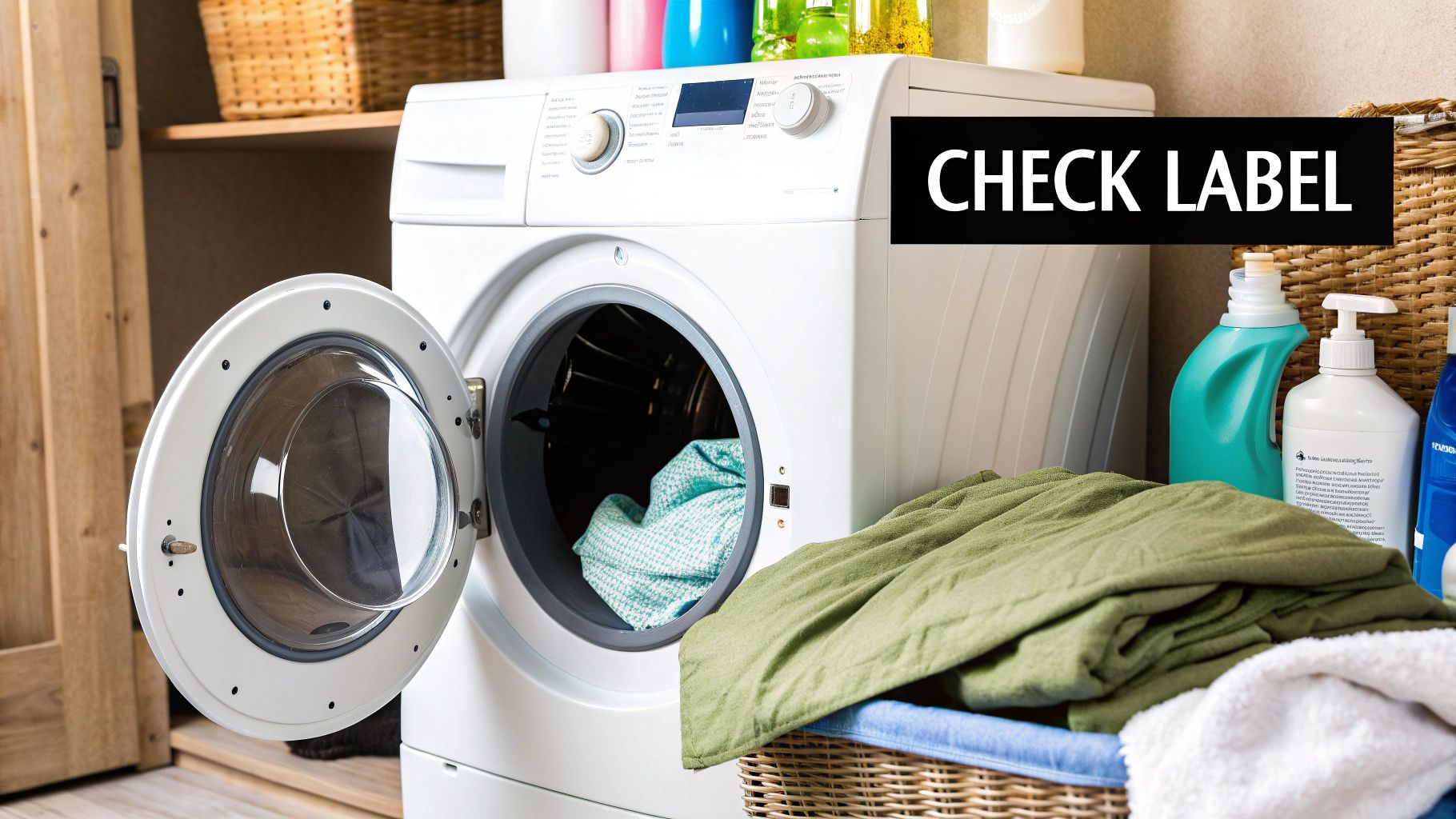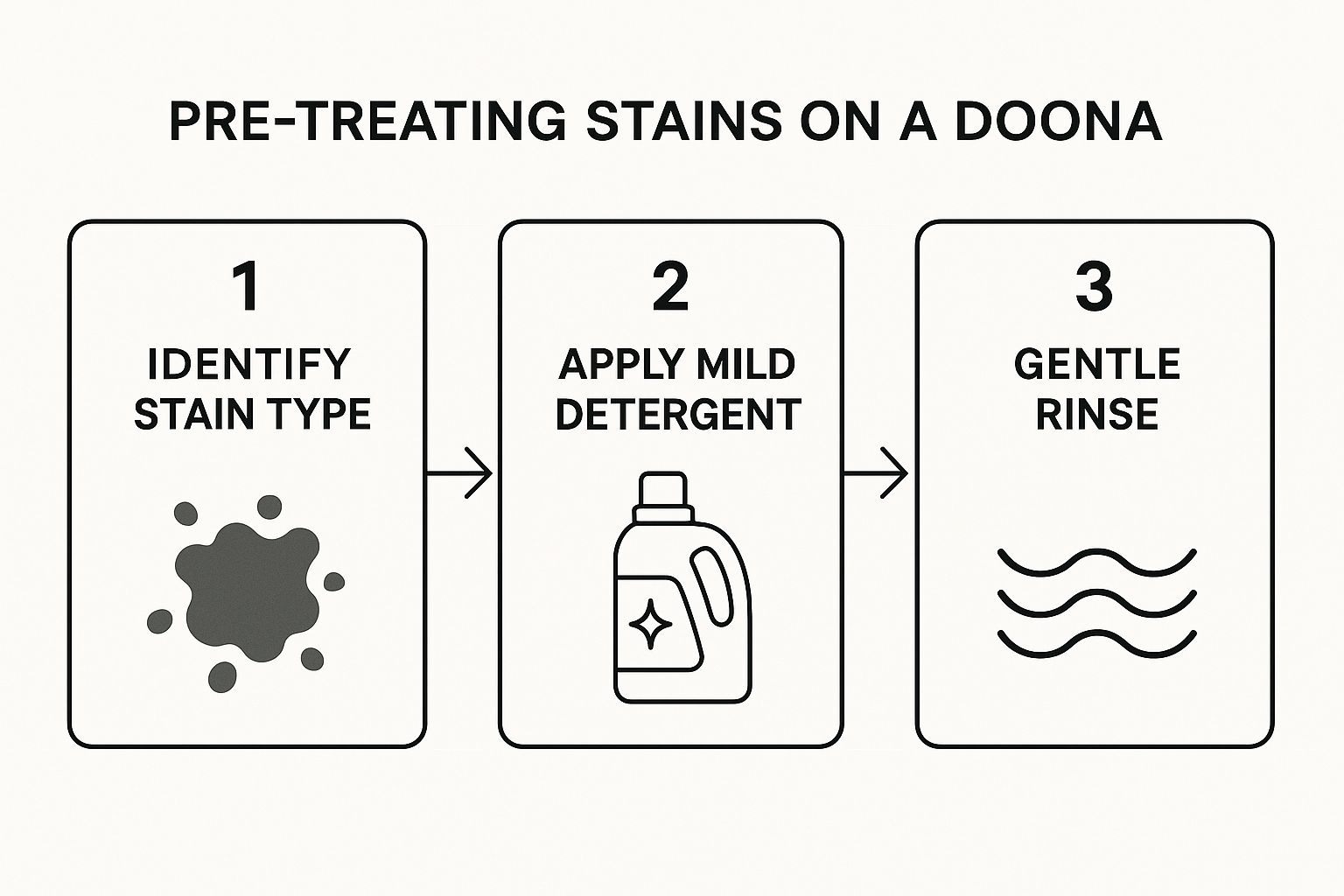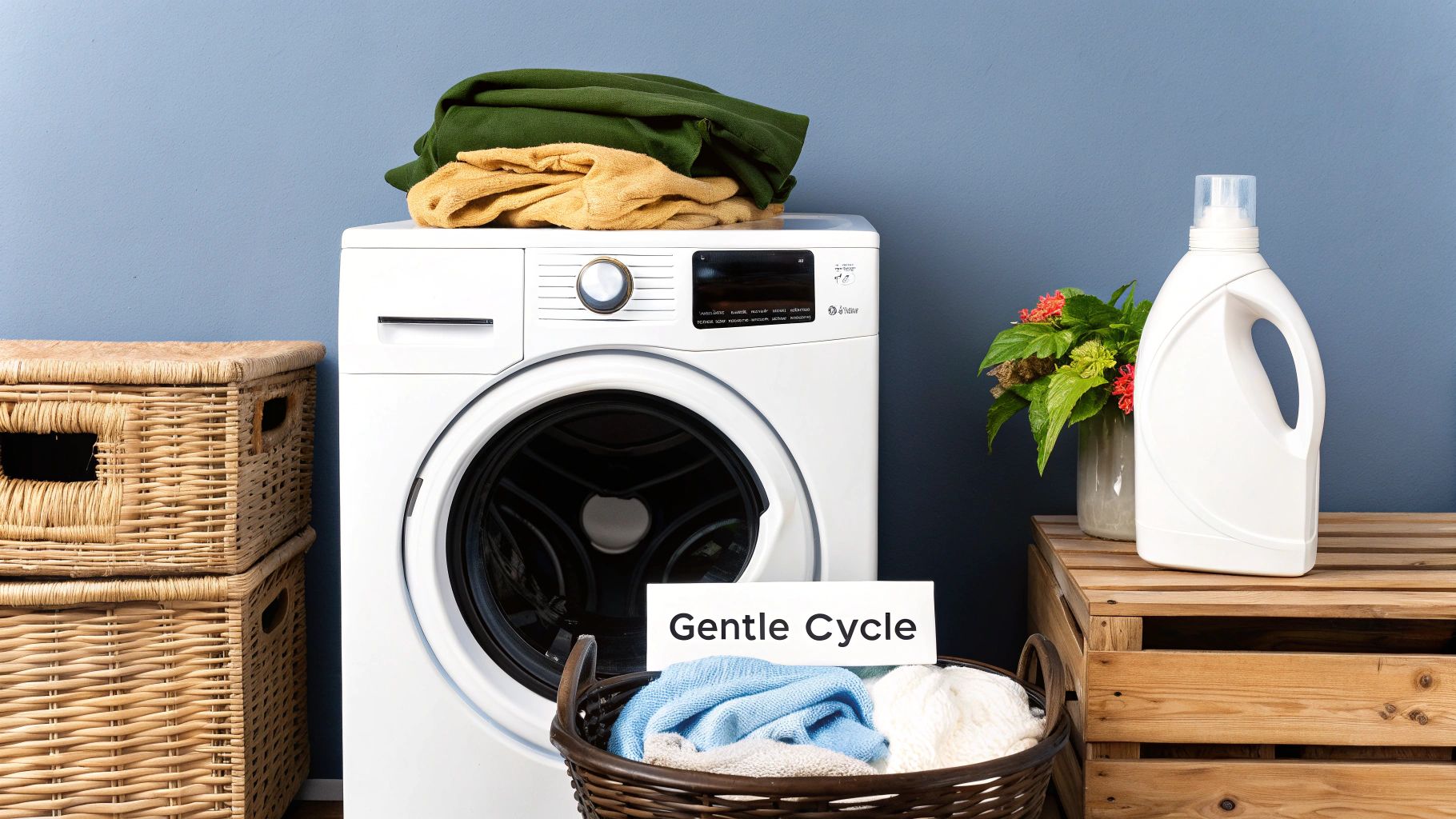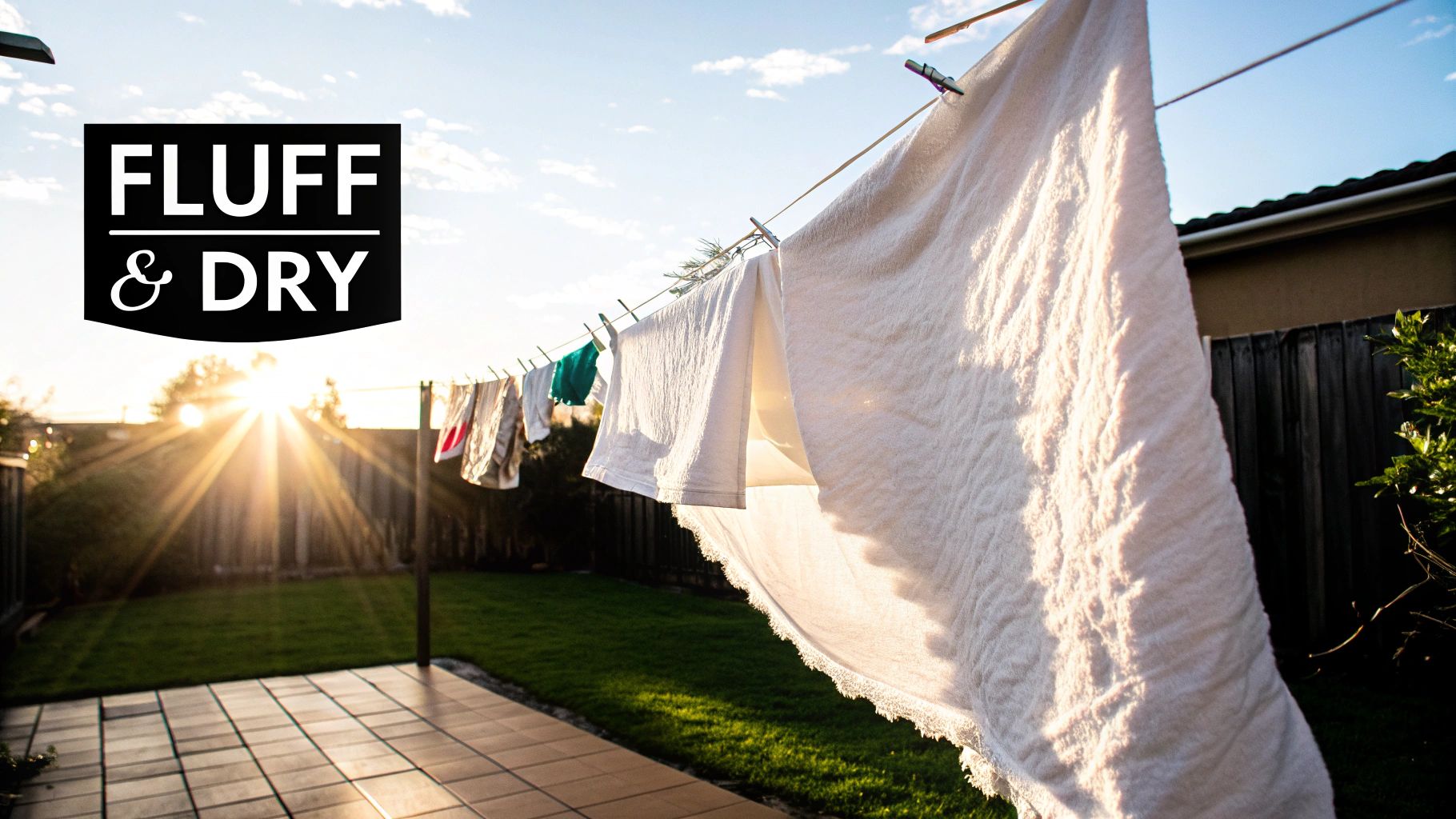Ever stared at your doona and felt a sense of dread at the thought of washing it? You're not alone. The good news is that knowing how to wash doonas properly is simpler than you think. For most, all it takes is a large-capacity machine, a gentle cycle with cool water, and a mild detergent. Mastering this simple process is a game-changer for your home hygiene and ensures your cosy bed is a genuinely clean and healthy space.
Why Your Doona Needs a Regular Wash
What if you knew that after just a few months, you're snuggling up with more than just your doona? It slowly becomes home to a cocktail of dust mites, shed skin cells, and body oils.
This isn't just about feeling a bit grubby; it's a real health issue. A 2005 study found that pillows and duvets can harbour millions of fungal spores, which can trigger allergies and worsen asthma. This invisible buildup can turn your cosy retreat into a source of irritation and discomfort.
What's Really Hiding in Your Bedding?
Think of your doona as a giant sponge. Night after night, it absorbs a surprising amount of unwanted guests:
- Dust Mites: These microscopic critters thrive in warm, humid environments and feast on the dead skin cells we all shed. Their waste is a powerful allergen for many people.
- Sweat and Body Oils: We all perspire during sleep, and these fluids seep deep into the doona's fibres, creating an ideal breeding ground for bacteria and causing those stubborn yellow stains.
- Dead Skin Cells: The average person sheds enough skin daily to feed millions of dust mites, and much of it ends up in your bedding.
An unwashed doona isn't just a little dirty—it's a thriving ecosystem that can directly impact your breathing and sleep quality.
Why Regular Washing is a Must
Learning how to wash doonas isn't just another chore; it's a vital part of maintaining a healthy home. Australian hygiene experts recommend washing your doona at least twice a year to control the buildup of dirt, oils, and allergens. You can find more insights on why professional cleaning is so important for your health.
For example, imagine someone with dust allergies notices their sneezing and itchy eyes are always worse at night. They might blame pollen, not realising the real culprit is the doona they're wrapped in. A thorough wash often brings immediate relief. Regular cleaning also helps your investment last longer by preventing fibre breakdown from sweat and oils.
Getting Your Doona Ready for the Wash

Before your doona touches water, a few minutes of prep can make the difference between a fluffy clean and a lumpy mess. Think of it as a pre-flight check for your bedding.
The golden rule? Always read the care label first. This little tag is your doona's instruction manual. It tells you exactly what the filling and fabric can handle, from water temperature to the best drying method.
Decoding the Care Label
Laundry symbols can look like a secret code, but they're simple once you know them. Ignoring them is a fast way to shrink wool, damage down, or melt synthetic fibres.
Here are key symbols on Aussie doonas:
- A tub with a number: This is the max water temperature in Celsius (e.g., 30° or 40°).
- A tub with a hand: This means hand-wash only. Don't risk it in the machine.
- A crossed-out tub: A clear "Do Not Wash" sign. This item needs professional cleaning.
- A triangle: The symbol for bleach. If crossed out, keep bleach away.
A "Dry Clean Only" label requires caution. The solvents can strip natural oils from down and feathers, ruining their insulating properties. It's often better to find a launderer who offers specialised wet-cleaning services for bedding.
A Quick Guide to Doona Materials
Here’s a handy reference for common doona types. Remember, your care label is always the final authority!
| Doona Material Washing Guide | ||
|---|---|---|
| Material Type | Recommended Washing Method | Drying Tip |
| Down & Feather | Machine wash on gentle/delicate cycle (if machine is large enough) or professional laundering. | Tumble dry on low heat with dryer balls to re-fluff the fill. |
| Wool | Hand wash or use a machine's specific wool cycle. Avoid agitation. | Air dry flat in the shade. Direct sun can yellow and damage the wool. |
| Cotton | Machine washable. Typically robust. | Can be tumble dried on a medium setting or line dried. |
| Synthetic (Polyester/Microfibre) | Machine washable on a gentle cycle. | Tumble dry on low heat. High heat can cause the fibres to melt and clump. |
| Bamboo | Gentle machine wash in cold water. | Tumble dry on a low/delicate setting or line dry in the shade. |
Inspect for Damage and Treat Stains
Next, lay your doona flat and check for rips, broken stitches, or weak seams. A tiny hole can become a major tear in the wash, spilling filling everywhere. A few stitches now can save a huge headache later.
This is also the perfect time to spot-treat stains. A small coffee spill or makeup smudge is much easier to lift before it's set by heat.
For example, a guest once spilled red wine on a white microfibre doona. Instead of panicking, I blotted it immediately and treated it with a gentle stain remover before the main wash. It came out perfectly. If I'd just tossed it in, the heat would have set that stain forever.
The "Will It Fit?" Test
Finally, is your machine big enough? A doona needs room to tumble in water to get clean. If it's crammed in, you'll get a poorly washed, soap-logged mess and risk straining your machine's motor.
Here's a simple test: place the doona in the drum. It should take up no more than two-thirds of the space. If you have to stuff it in, your machine is too small. For most king-size doonas, a trip to the local laundromat and their large-capacity front-loaders is your safest bet.
Machine Washing Your Doona at Home
If the care label gives you the green light, using your own machine is the easiest way to get your doona fresh and clean. Knowing how to wash your doona at home saves a trip to the laundromat, but only if you do it right.
The most important factor is machine size. You need a large-capacity, front-loading machine. Top-loaders with a central agitator can twist and tear the fabric, causing clumpy, uneven filling. Your doona needs space to tumble freely.
Setting Up for a Gentle Clean
Once you're sure your machine can handle the bulk, focus on the settings. Always choose a cold, gentle cycle. Hot water can cause shrinkage in natural fibres like wool and can even melt synthetic fillings.
Use a mild, liquid detergent sparingly. Too much soap can leave a residue that irritates skin and makes the filling feel stiff. And skip the fabric softener—it coats the fibres, reducing their natural fluffiness and warmth. For precious down quilts, getting it right is crucial. Find specific advice in our essential guide on how to wash and care for down quilts.
The Secret to a Residue-Free Rinse
To ensure every bit of soap is washed out, I always recommend running an extra rinse cycle. It’s a simple step that prevents detergent buildup from degrading the fibres over time.
Pro Tip: Toss a couple of wool dryer balls or clean tennis balls into the drum. As the machine tumbles, the balls bounce around, breaking up potential clumps and keeping the filling evenly distributed.
Before you press 'start', load the doona evenly to keep the machine balanced and prevent loud banging during the spin cycle.
This guide shows you how to tackle stubborn stains before the main wash.

As you can see, spot-treating is key. By identifying the stain, dabbing it with a gentle detergent, and giving it a light rinse, you stop it from setting permanently.
Hand Washing and Professional Cleaning Options

Sometimes, your doona is too big for the machine, or the care label says "hand wash only." In these cases, you can either roll up your sleeves or call a professional.
Hand washing is doable, but it's a workout. Your bathtub is the best tool for the job.
The Bathtub Method: A Practical Guide
Fill your tub with cool water and a small amount of gentle, liquid detergent. Submerge the doona completely and let it soak for at least an hour to allow the detergent to break down dirt and oils.
Next, gently press and squeeze sections of the doona against the bottom of the tub, like you're kneading dough. This pushes soapy water through the filling without damage. Never wring or twist the doona, as this can rip internal stitching and cause permanent clumping.
Drain the soapy water and refill the tub with fresh, cool water. Repeat the squeezing motion to rinse. You’ll need to drain and repeat until the water runs clear. Ensuring all soap is removed is a key tip for hypoallergenic bedding care to avoid skin irritation.
When to Call the Professionals
There are times when calling a professional is the smarter move. For delicate materials like silk or certain wools, a professional launderer has the right equipment and experience. The same applies to super king-sized doonas that are a nightmare to handle at home.
Laundry services note that the yellowing on doonas comes mostly from sweat, which home machines struggle to remove from such a bulky item. A saturated doona is incredibly heavy and can strain your machine's motor. Learn more from experts on how often you should clean your doona.
Think of professional cleaning as an investment in your doona's lifespan. If you’re ever unsure, our FAQs page has more advice. For high-quality items from Sienna Living, professional care is the best way to keep them feeling luxurious.
The Secret to Drying a Perfectly Fluffy Doona

Washing is only half the battle. The secret to a perfectly fluffy doona is all in the drying. Getting this wrong can lead to mould, mildew, and clumps, undoing all your hard work.
The goal is to get your doona 100% dry, right to the core. A slightly damp doona is a breeding ground for mildew, which can ruin your bedding and cause health issues. Patience is key.
Using a Tumble Dryer for Maximum Fluff
If the care label allows, a tumble dryer is your quickest path to a cloud-like finish. Use low heat and ensure the doona has plenty of space to tumble. High heat can damage or melt delicate fillings.
To prevent the filling from bunching up, use the 'tennis ball trick'.
- Add two or three clean tennis balls (or wool dryer balls) to the dryer with your doona.
- As they bounce around, they break up clumps and help warm air circulate.
- This simple move keeps the filling distributed and fluffs it back to its original loft.
A tip I swear by: Pause the dryer every 30 minutes. Pull the doona out, give it a vigorous shake, and manually break up any clumps. Then, pop it back in. This ensures every part of the filling gets dry.
The Art of Air-Drying
Don't have a large dryer? Air-drying is a great choice, especially on a warm, breezy day. The key is to maximise airflow.
Drape the doona over two parallel clotheslines to create an air channel that flows above, below, and through the middle, speeding up drying time. If you only have one line, rotate and flip it regularly.
Air-drying can be great for allergy sufferers, but a doona that dries too slowly can attract allergens. A key part of proper hypoallergenic bedding care is ensuring a fast, complete dry.
Whichever method you choose, do a final "squeeze test." Pinch different sections, especially the corners and thickest parts. If you feel any coolness or dampness, it’s not done. A dry doona feels light, airy, and consistently warm.
Your Top Doona Washing Questions Answered
https://www.youtube.com/embed/vEubUD72e7M
Even with a plan, washing a doona can raise questions. Here are answers to the most common queries to help you get it right every time.
How Often Should I Really Wash My Doona?
For most Australian households, washing your doona twice a year is ideal. This keeps it hygienic without being excessive.
However, if you have allergies, share your bed with a pet, or sweat a lot at night, you should increase this to every three or four months. The best defence? Use a quality doona cover and wash it weekly with your sheets.
Can I Use Bleach on Yellow Stains?
Avoid chlorine bleach. It's too harsh for delicate fillings like down or wool and can cause irreversible damage.
For stubborn yellow stains, a gentler, oxygen-based bleach is a safer option. You can also pre-treat the area with a paste of bicarb soda and water. Always test on a small, hidden corner first.
How Do I Fix a Clumpy Doona?
A clumpy doona is usually still damp inside. Don't worry, it's an easy fix! It just needs more drying time.
Put it back in a large dryer on a low heat setting with a few wool dryer balls or clean tennis balls. They will bounce around and break up the clumps. Every 20-30 minutes, pause the dryer, pull the doona out, and give it a vigorous shake to help fluff it up. Repeat until it feels completely dry, light, and evenly filled.
Is a Laundromat Better for a King-Size Doona?
Yes, absolutely. A standard home washing machine is too small to handle a king-size doona properly. Cramming it in results in a poor clean and puts a huge strain on your machine's motor.
A laundromat is the smart move. Their commercial-grade machines have the space your doona needs to tumble freely for a thorough and safe clean.
If you have more questions, check our complete frequently asked questions page for more guidance.
At Sienna Living, we believe a healthy sleep environment starts with clean, high-quality bedding. Explore our collection of luxurious, easy-to-care-for doonas designed to provide ultimate comfort and stand the test of time. Discover your perfect doona today at https://www.siennaliving.com.au.

